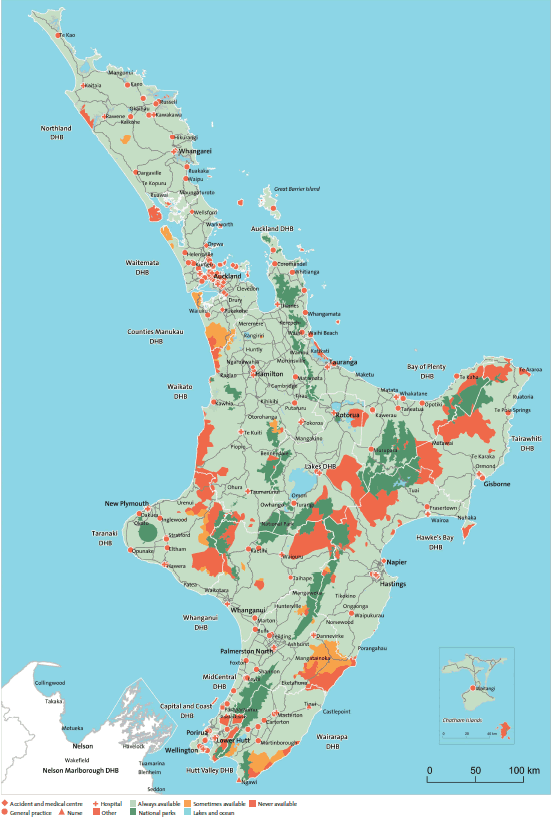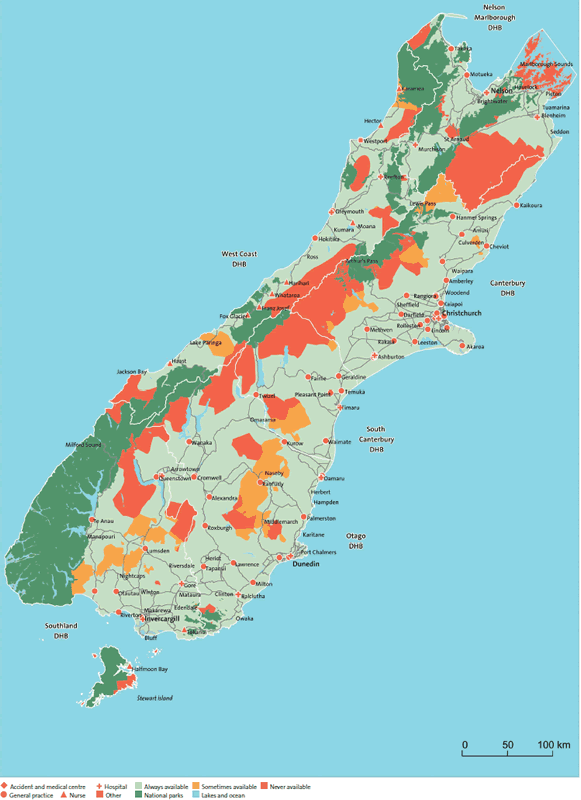Part 3: Availability of after-hours services
3.1
In this Part, we discuss:
- what DHBs were required, or had committed, to do about the availability of after-hours services; and
- the availability of after-hours services within 60 minutes' drive.
Summary of our findings
3.2
At the time of our audit fieldwork, and according to the information that DHBs confirmed to us as accurate at that time, after-hours services were always available within 60 minutes' drive for almost all (99.7%) of New Zealand's population in a typical week. Service coverage, in terms of geographic availability, was more than that required by the 2009/10 Service Coverage Schedule.
3.3
The people who had to drive for longer than 60 minutes to reach the nearest after-hours service arranged by their own DHB were generally in rural areas.
What district health boards were required to do
3.4
Under the 2009/10 Service Coverage Schedule for DHBs, after-hours services are expected to be available within 60 minutes' travel time for 95% of a DHB's population.9 Where a nurse delivers those after-hours services, medical back-up has to be available.10
3.5
Guidance about the availability of after-hours services within 60 minutes' travel time was provided in the report of the After Hours Primary Health Care Working Party. The report stated that:
The travel time applies to travel by road from the homes of the enrolled population to the site of the after hours service.
PHOs and DHBs, when planning after hours services, should generally limit the need for communities to travel in excess of 60 minutes to people living in small remote settlements or scattered populations.11
Availability of after-hours services within 60 minutes' drive
All DHBs' after-hours plans met the Government's expectation that they make after-hours services available to 95% of their population within 60 minutes' travel time.
3.6
We reviewed DHBs' after-hours plans (which included DHB funding proposals and other documents) to determine where after-hours services arrangements were planned. We confirmed with DHBs that this reflected arrangements within the district at that time. We used this information and analysis from a geographical information system to determine what percentage of each DHB's population could reach after-hours services within 60 minutes' travel by road (see Appendix 1 for more information about our analysis).
How we determined the availability of after-hours services
3.7
We worked with a geographical information systems specialist to determine, for each DHB, the percentage of the population living within 60 minutes' drive of an after-hours service. When carrying out this analysis, we assumed that people drive from their homes to the nearest after-hours service by the fastest road route.
3.8
We carried out our analysis twice. First, we assumed that people would travel to the nearest after-hours service regardless of whether that service was within their DHB's district (see Figure 3). We repeated the analysis assuming that people would travel to the nearest after-hours service within their DHB's district (see Figure 4).
3.9
The results of our analysis show that after-hours services planned by DHBs met the Government's expectation that after-hours services be available to 95% of a DHB's population within 60 minutes' drive.
3.10
Figure 3 shows the percentage of each DHB's population that always had an after-hours service available within 60 minutes' drive. It also shows the number of people for whom an after-hours service was sometimes available, and those for whom it was never available, within 60 minutes' drive. It assumes that people would and could travel to the nearest after-hours service regardless of whether that service was within their DHB's district. Figure 4 shows the same information, but assumes instead that people would and could travel to the nearest available after-hours service within their DHB's district.
Figure 3
Percentage and number, by district health board, of the population with after-hours services that were always available, were sometimes available, or were never available within 60 minutes' drive (in a typical week, and regardless of whether the service was within a district health board's district)
| DHB | DHB population at the 2006 Census | % of DHB population always with after-hours services available within 60 minutes' drive | Number of people after-hours services were sometimes available to within 60 minutes' drive | Number of people after-hours services were never available to within 60 minutes' drive |
|---|---|---|---|---|
| Auckland | 404,670 | 99.9 | 0 | 485 |
| Bay of Plenty | 195,024 | 99.9 | 0 | 224 |
| Canterbury | 466,365 | 99.9 | 131 | 306 |
| Capital and Coast | 266,688 | 100.0 | 0 | 0 |
| Counties Manukau | 433,053 | 99.4 | 2359 | 73 |
| Hawke's Bay | 148,293 | 99.6 | 4 | 547 |
| Hutt Valley | 136,050 | 100.0 | 0 | 0 |
| Lakes | 98,421 | 100.0 | 0 | 0 |
| MidCentral | 158,808 | 99.2 | 768 | 538 |
| Nelson Marlborough | 130,080 | 99.0 | 0 | 1283 |
| Northland | 148,437 | 99.6 | 15 | 525 |
| Otago | 179,481 | 99.0 | 1785 | 80 |
| South Canterbury | 53,955 | 99.6 | 131 | 93 |
| Southland | 106,767 | 99.2 | 568 | 305 |
| Tairawhiti | 44,433 | 98.2 | 0 | 783 |
| Taranaki | 104,355 | 99.7 | 72 | 244 |
| Waikato | 339,204 | 99.7 | 268 | 664 |
| Wairarapa | 38,607 | 99.1 | 267 | 81 |
| Waitemata | 481,852 | 99.9 | 323 | 81 |
| West Coast | 31,371 | 97.9 | 630 | 35 |
| Whanganui | 62,190 | 99.9 | 14 | 53 |
| All DHBs | 4,028,104 | 99.7 | 7335 | 6400 |
Note: Darker shading has been used to highlight the DHBs with 1000 or more residents who never had or only sometimes had after-hours services available within 60 minutes' drive.
3.11
Although, at the time of our analysis, planned after-hours services were always available to almost all DHB populations within the required travel time, there were 13,735 people who may have had to travel for longer than 60 minutes to reach an after-hours service regardless of whether the service was within their DHB district.
3.12
The expectation in the 2009/10 Service Coverage Schedule is based on the percentage of a DHB's population that services are provided to. The DHBs with more than 1000 residents who did not always have after-hours services available within 60 minutes' drive (regardless of DHB district) were Counties Manukau, MidCentral, Nelson Marlborough, and Otago.
Figure 4
Percentage and number, by district health board, of the population with after-hours services that were always available, were sometimes available, or were never available within 60 minutes' drive (in a typical week, and within a district health board's district)
| DHB | DHB population at the 2006 Census | % of DHB population always with after-hours services available within 60 minutes' drive | Number of people after-hours services were sometimes available to within 60 minutes' drive | Number of people after-hours services were never available to within 60 minutes' drive |
|---|---|---|---|---|
| Auckland | 404,670 | 99.9 | 0 | 485 |
| Bay of Plenty | 195,024 | 99.9 | 0 | 224 |
| Canterbury | 466,365 | 99.9 | 131 | 306 |
| Capital and Coast | 266,688 | 100.0 | 0 | 0 |
| Counties Manukau | 433,053 | 99.3 | 2771 | 73 |
| Hawke's Bay | 148,293 | 99.6 | 1 | 576 |
| Hutt Valley | 136,050 | 100.0 | 0 | 0 |
| Lakes | 98,421 | 99.7 | 253 | 0 |
| MidCentral | 158,808 | 93.2 | 9759 | 1109 |
| Nelson Marlborough | 130,080 | 99.0 | 0 | 1283 |
| Northland | 148,437 | 99.6 | 15 | 525 |
| Otago | 179,481 | 98.9 | 1785 | 201 |
| South Canterbury | 53,955 | 99.6 | 15 | 223 |
| Southland | 106,767 | 99.2 | 569 | 310 |
| Tairawhiti | 44,433 | 97.9 | 8 | 913 |
| Taranaki | 104,355 | 99.6 | 79 | 339 |
| Waikato | 339,204 | 99.6 | 752 | 694 |
| Wairarapa | 38,607 | 99.1 | 267 | 81 |
| Waitemata | 481,852 | 99.9 | 323 | 81 |
| West Coast | 31,371 | 97.9 | 630 | 35 |
| Whanganui | 62,190 | 99.9 | 14 | 54 |
| All DHBs | 4,028,104 | 99.4 | 17,372 | 7512 |
Note: Darker shading has been used to highlight the DHBs with 1000 or more residents who never had or only sometimes had after-hours services available within 60 minutes' drive.
3.13
Figure 5 shows, for the North and South Islands, the areas where after-hours services were always available, were sometimes available, or were never available within 60 minutes' drive during a representative week, regardless of whether the service was available within the district health board district.
3.14
In Part 8, we provide more detailed maps showing this information for each DHB.
3.15
We have a comprehensive technical document that outlines the information sources, assumptions, and analytical methodology used to prepare these maps and tables. Readers interested in obtaining a copy can email their request to [email protected].
Figure 5
Areas where after-hours services were always available, were sometimes available, or were never available within 60 minutes' drive for the population of each district health board (in a typical week, and regardless of whether the service was within a district health board's district)
[PDF of Figure 5 (382kB, 2 pages). These maps should be printed on A3 paper.]


Nurse-led services had medical back-up arrangements
3.16
As we noted in paragraph 3.4, where a nurse delivers a service, there is a requirement in the 2009/10 Service Coverage Schedule for the nurse to have medical back-up. DHBs' after-hours plans showed, or DHBs told us, that they had back-up arrangements for planned nurse-led services. The back-up arrangements typically took the form of "standing orders",12 and a doctor available on call.
9: Ministry of Health, 2009/10 Service Coverage Schedule, page 15.
10: Ministry of Health, 2009/10 Service Coverage Schedule, page 15.
11: After Hours Primary Health Care Working Party (July 2005), Towards Accessible, Effective and Resilient After Hours Primary Health Care Services: Report of the After Hours Primary Health Care Working Party, Ministry of Health, Wellington, section 4.2, page 11 (pdf version).
12: A standing order is a written instruction issued by a doctor that authorises other health practitioners, such as nurses, to supply and administer prescription medicines or controlled drugs to patients specified in the instruction, without a prescription. This definition is based on the Ministry of Health's Guidelines for the Development and Operation of Standing Orders (revised 2006), page 2.
page top
